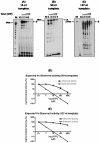Biochemical characterization of enzyme fidelity of influenza A virus RNA polymerase complex
- PMID: 20454455
- PMCID: PMC2861597
- DOI: 10.1371/journal.pone.0010372
Biochemical characterization of enzyme fidelity of influenza A virus RNA polymerase complex
Abstract
Background: It is widely accepted that the highly error prone replication process of influenza A virus (IAV), together with viral genome assortment, facilitates the efficient evolutionary capacity of IAV. Therefore, it has been logically assumed that the enzyme responsible for viral RNA replication process, influenza virus type A RNA polymerase (IAV Pol), is a highly error-prone polymerase which provides the genomic mutations necessary for viral evolution and host adaptation. Importantly, however, the actual enzyme fidelity of IAV RNA polymerase has never been characterized.
Principal findings: Here we established new biochemical assay conditions that enabled us to assess both polymerase activity with physiological NTP pools and enzyme fidelity of IAV Pol. We report that IAV Pol displays highly active RNA-dependent RNA polymerase activity at unbiased physiological NTP substrate concentrations. With this robust enzyme activity, for the first time, we were able to compare the enzyme fidelity of IAV Pol complex with that of bacterial phage T7 RNA polymerase and the reverse transcriptases (RT) of human immunodeficiency virus (HIV-1) and murine leukemia virus (MuLV), which are known to be low and high fidelity enzymes, respectively. We observed that IAV Pol displayed significantly higher fidelity than HIV-1 RT and T7 RNA polymerase and equivalent or higher fidelity than MuLV RT. In addition, the IAV Pol complex showed increased fidelity at lower temperatures. Moreover, upon replacement of Mg(++) with Mn(++), IAV Pol displayed increased polymerase activity, but with significantly reduced processivity, and misincorporation was slightly elevated in the presence of Mn(++). Finally, when the IAV nucleoprotein (NP) was included in the reactions, the IAV Pol complex exhibited enhanced polymerase activity with increased fidelity.
Significance: Our study indicates that IAV Pol is a high fidelity enzyme. We envision that the high fidelity nature of IAV Pol may be important to counter-balance the multiple rounds of IAV genome amplification per infection cycle, which provides IAV Pol with ample opportunities to generate and amplify genomic founder mutations, and thus achieve optimal viral mutagenesis for its evolution.
Conflict of interest statement
Figures





References
-
- Hu DJ, Dondero TJ, Rayfield MA, George JR, Schochetman G, et al. The emerging genetic diversity of HIV. The importance of global surveillance for diagnostics, research, and prevention. JAMA. 1996;275:210–216. - PubMed
-
- Berkhout B, Das AT, Beerens N. HIV-1 RNA editing, hypermutation, and error-prone reverse transcription. Science. 2001;292:7. - PubMed
-
- Ji JP, Loeb LA. Fidelity of HIV-1 reverse transcriptase copying RNA in vitro. Biochemistry. 1992;31:954–958. - PubMed
Publication types
MeSH terms
Substances
Grants and funding
LinkOut - more resources
Full Text Sources
Other Literature Sources
Miscellaneous

